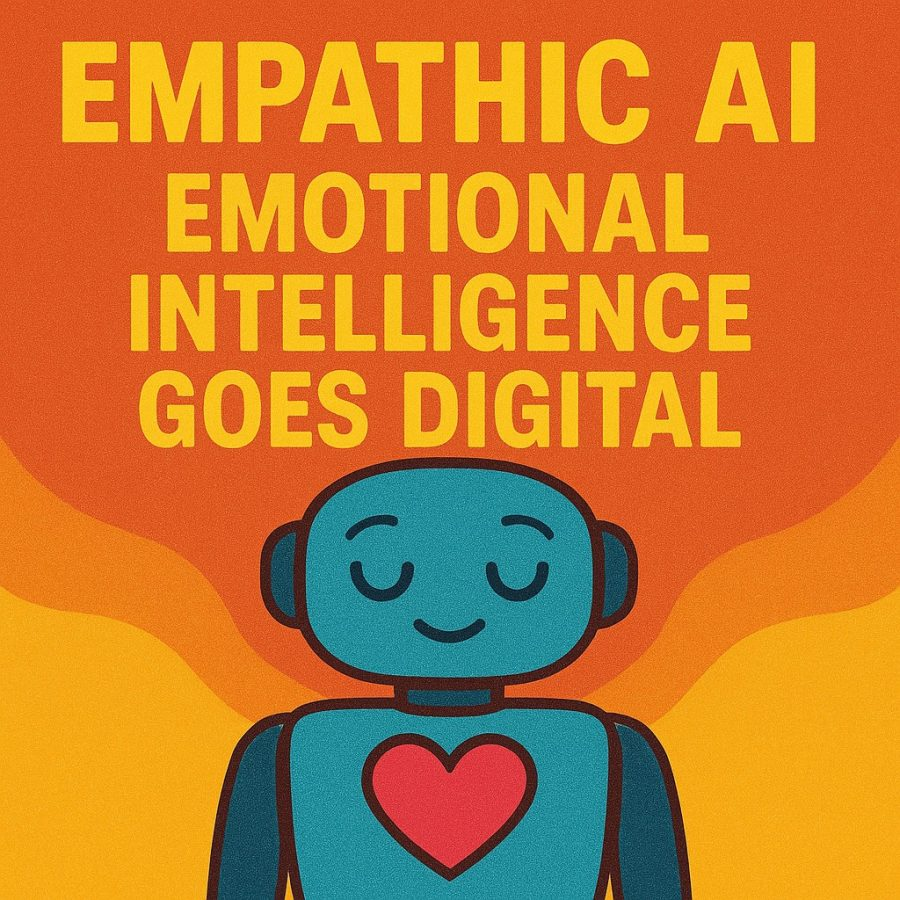Views: 2

AI isn’t just getting smarter, it’s getting softer. Empathetic virtual assistants that understand tone, sentiment, and emotional nuance are now being deployed. Some in sensitive fields like healthcare, housing, and mental health, highlighting both AI’s potential and the need for safe, ethical design.
Technology has always had a way of surprising us. Just when we thought our gadgets could not get any smarter, they learned how to talk back. Then they learned how to recommend what to watch, what to eat, and which vacuum robot could be trusted not to attack the family dog. Now the newest frontier has emerged: Empathetic AI: Emotional Intelligence Goes Digital.
Machines are not only listening, they are trying to feel. Well, not exactly feel in the way humans do, but they are learning to interpret our emotional states and respond with sensitivity. Imagine your GPS saying, “I know you are stressed, let’s take the scenic route,” or your email app muttering, “You sound angry, maybe wait before sending that message.” These are not science fiction scenes. They are real possibilities built on the rise of empathetic AI.
In this guide, we will explore how emotional intelligence is becoming part of artificial intelligence, how it is showing up in our daily lives, why it matters for businesses and individuals, and why it can be as funny as it is useful. Strap in, because this is where digital logic meets human feelings in a partnership filled with comedy, concern, and curiosity.
The Long March from Logic to Empathy
In the beginning, machines were calculators. Cold, rigid, and unapologetically focused on math. They were brilliant at crunching numbers but would not have recognized a sad face even if it was drawn across the monitor with a marker. Over time, however, human interaction with technology demanded more.
The personal computer had to be approachable. The smartphone had to be friendly. Virtual assistants like Siri and Alexa had to sound conversational. Step by step, we nudged machines closer to behaving like us. The newest leap is clear: empathy. Empathetic AI: Emotional Intelligence Goes Digital because it has to. We expect our technology to understand us better than ever before, and companies realize that products lacking emotional insight fall flat in competitive markets.
Why Emotional Intelligence in AI Matters
Humans are emotional creatures. Even in business, decisions often have emotional weight. A chatbot that fails to detect customer frustration risks losing a sale. An educational app that cannot sense when a learner feels confused risks leaving the student behind.
This is why empathetic AI matters. By analyzing tone, choice of words, facial cues, and behavior, these systems can interpret emotional states and respond appropriately. For example:
- A tutoring system slowing down when it detects hesitation.
- A shopping assistant suggesting cheerful options if the user seems down.
- A healthcare bot noticing signs of anxiety and offering calming techniques.
When machines respond to feelings, experiences become more human-centered. That is not just a technical win, it is a commercial one. Businesses that use empathetic AI see stronger engagement and customer loyalty because people feel understood, even by code.
The Building Blocks of Digital Empathy
So how does a machine become emotionally intelligent without therapy sessions or inspirational posters on the wall? The answer lies in three major tools:
- Natural Language Processing (NLP): By studying word choice, tone, and rhythm, AI can guess whether the user is happy, stressed, or sarcastic.
- Computer Vision: Cameras and sensors track facial expressions, posture, and micro-expressions that reveal hidden emotions.
- Behavioral Analytics: Keystrokes, typing speed, pauses, and even voice pitch provide clues about emotional state.
Together, these give machines a sense of empathy, or at least a digital approximation of it. And while machines do not feel emotions themselves, they can mirror empathy convincingly enough to make interactions smoother.
Everyday Encounters with Empathetic AI
You might already be dealing with empathetic AI without realizing it. Some practical examples include:
- Customer Service: Chatbots capable of routing frustrated users to live agents.
- Healthcare Apps: Programs like Woebot that deliver cognitive behavioral support with emotional sensitivity.
- Automotive Systems: Cars that track driver stress and suggest breaks.
- Smart Devices: Virtual assistants that adapt their tone depending on how you speak to them.
All of these rely on the same principle: empathetic AI: Emotional Intelligence Goes Digital to make human-machine interactions feel more natural.
Why cook when you can have it delivered? DoorDash is the answer.
The Funny Side of Artificial Empathy
Now, let’s be honest: empathy is hard, even for humans. Machines get it wrong often, and the results can be hilarious.
Picture this: You angrily mutter at your computer, “Fantastic, just what I needed!” after it crashes mid-report. The AI, interpreting your words literally, responds with “You’re welcome!” If sarcasm is the Mount Everest of emotional intelligence, machines are still stuck at base camp.
Another example: a voice assistant once suggested relaxation music when a user shouted at it for ordering the wrong pizza toppings. To the AI, yelling equals stress, and stress requires calming. To the human, yelling meant “stop wasting my money.” Misalignments like these will continue until systems become better at context, but until then, we get comedy gold.
Empathetic AI in the Workplace
Workplaces are being transformed by digital empathy. Video conferencing tools can now analyze engagement levels during meetings, offering managers real-time data on who is paying attention. Recruitment platforms claim they can analyze voice patterns to detect confidence or nervousness in interviews.
Customer support agents are increasingly guided by AI systems that whisper suggestions during calls: “Lower your voice, this customer is frustrated,” or “Offer a discount now.” It is like having a digital sidekick who never takes coffee breaks.
Yet there are risks. Over-reliance on emotional analytics could lead to false assumptions. After all, not everyone frowns because they are upset. Sometimes they just forgot their glasses.
Companionship and Care
One of the most touching uses of empathetic AI is companionship. For seniors living alone or veterans dealing with isolation, companionship bots are designed to provide friendly conversation, reminders, and emotional support. They notice when you sound down and respond with encouragement.
Critics argue this risks replacing human contact with artificial substitutes. Supporters counter that something is better than nothing, especially when human caregivers are stretched thin. Here again, empathetic AI: Emotional Intelligence Goes Digital not as a replacement for people, but as an assistant filling gaps in care.
The Ethical Tightrope
The power of empathetic AI also brings danger. If a machine knows when you are sad, it could exploit that vulnerability. Imagine a shopping app sensing disappointment and nudging you to buy comfort products. Or political tools tweaking messages when fear is detected.
Regulation, transparency, and strong ethical guidelines are needed to keep emotional intelligence from turning into emotional manipulation. Without safeguards, empathetic AI risks being less about compassion and more about control.
Global Challenges of Digital Empathy
Culture shapes emotions. A smile in one country can mean friendliness, while in another it can signal discomfort. empathetic AI trained in one culture may misinterpret cues in another.
For example, direct eye contact is seen as confidence in the United States but as disrespect in parts of Asia. If AI misreads these signals, results can be awkward or offensive. Developers must therefore train systems on diverse datasets to avoid cultural blind spots.
Download Honey & Save Automatically with it’s Coupon Clipping Magic. Did I mention it’s Free?
(Click the image below)
The Future of Empathetic AI
The current state of empathetic AI is impressive but limited. In many ways, it is like a freshman psychology student: enthusiastic but prone to mistakes. With better training, larger datasets, and refined algorithms, empathetic AI could mature into a reliable partner.
Future possibilities include:
- Virtual reality avatars that mirror real emotions in real time.
- Personal AI coaches providing pep talks before big events.
- Healthcare monitoring that tracks emotional well-being alongside physical health.
It is not far-fetched to imagine devices that not only know how many steps you took but also how those steps made you feel.
Laughing Through the Digital Growing Pains
So where do we land? Empathetic AI is not perfect. It stumbles, it misreads, it sometimes suggests you take a nap when you just need coffee. But it is also one of the most humanizing leaps in technology to date.
By bringing emotional intelligence into the digital sphere, we create machines that do not just serve tasks but also understand context. And while they may never feel joy or sadness themselves, they can recognize ours and respond in ways that make life easier, friendlier, and often funnier.Maybe one day, when your AI assistant tells you, “It’s okay, tomorrow will be better,” you will laugh, nod, and realize the world really has changed. Empathetic AI: Emotional Intelligence Goes Digital, and along the way, it makes us reflect on how much we value empathy itself.




